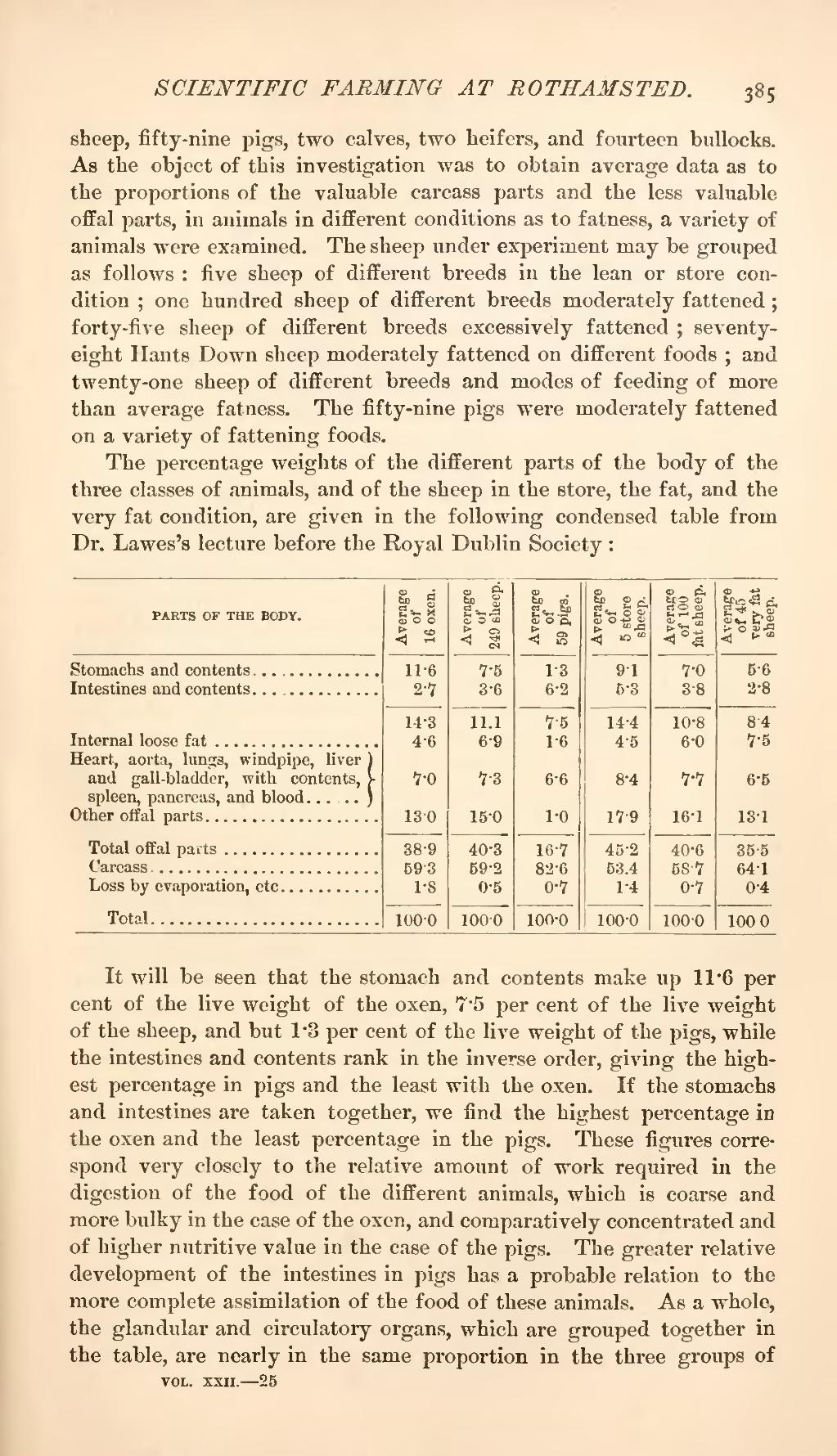sheep, fifty-nine pigs, two calves, two heifers, and fourteen bullocks. As the object of this investigation was to obtain average data as to the proportions of the valuable carcass parts and the less valuable offal parts, in animals in different conditions as to fatness, a variety of animals were examined. The sheep under experiment may be grouped as follows: five sheep of different breeds in the lean or store condition; one hundred sheep of different breeds moderately fattened; forty-five sheep of different breeds excessively fattened; seventy-eight Hants Down sheep moderately fattened on different foods; and twenty-one sheep of different breeds and modes of feeding of more than average fatness. The fifty-nine pigs were moderately fattened on a variety of fattening foods.
The percentage weights of the different parts of the body of the three classes of animals, and of the sheep in the store, the fat, and the very fat condition, are given in the following condensed table from Dr. Lawes's lecture before the Royal Dublin Society:
| PARTS OF THE BODY. | Average of 16 oxen. | Average of 249 sheep. | Average of 59 pigs. | Average of 5 store sheep. | Average of 100 fat sheep. | Average of 45 very fat sheep. | |
| Stomachs and contents | 11·6 | 7·5 | 1·3 | 9·1 | 7·0 | 5·6 | |
| Intestines and contents | 2·7 | 3·6 | 6·2 | 5·3 | 3·8 | 2·8 | |
| 14·3 | 11·1 | 7·5 | 14·4 | 10·8 | 8·4 | ||
| Internal loose fat | 4·6 | 6·9 | 1·6 | 4·5 | 6·0 | 7·5 | |
| Heart, aorta, lungs, windpipe, liver and gall-bladder, with contents, spleen, pancreas, and blood | 7·0 | 7·3 | 6·6 | 8·4 | 7·7 | 6·5 | |
| Other offal parts | 13·0 | 15·0 | 1·0 | 17·9 | 16·1 | 13·1 | |
| Total offal parts | 38·9 | 40·3 | 16·7 | 45·2 | 40·6 | 35·5 | |
| Carcass | 59·3 | 59·2 | 82·6 | 53·4 | 58·7 | 64·1 | |
| Loss by evaporation, etc. | 1·8 | 0·5 | 0·7 | 1·4 | 0·7 | 0·4 | |
| Total | 100·0 | 100·0 | 100·0 | 100·0 | 100·0 | 100·0 | |
It will be seen that the stomach and contents make up 11·6 per cent of the live weight of the oxen, 7·5 per cent of the live weight of the sheep, and but 1·3 per cent of the live weight of the pigs, while the intestines and contents rank in the inverse order, giving the highest percentage in pigs and the least with the oxen. If the stomachs and intestines are taken together, we find the highest percentage in the oxen and the least percentage in the pigs. These figures correspond very closely to the relative amount of work required in the digestion of the food of the different animals, which is coarse and more bulky in the case of the oxen, and comparatively concentrated and of higher nutritive value in the case of the pigs. The greater relative development of the intestines in pigs has a probable relation to the more complete assimilation of the food of these animals. As a whole, the glandular and circulatory organs, which are grouped together in the table, are nearly in the same proportion in the three groups of

